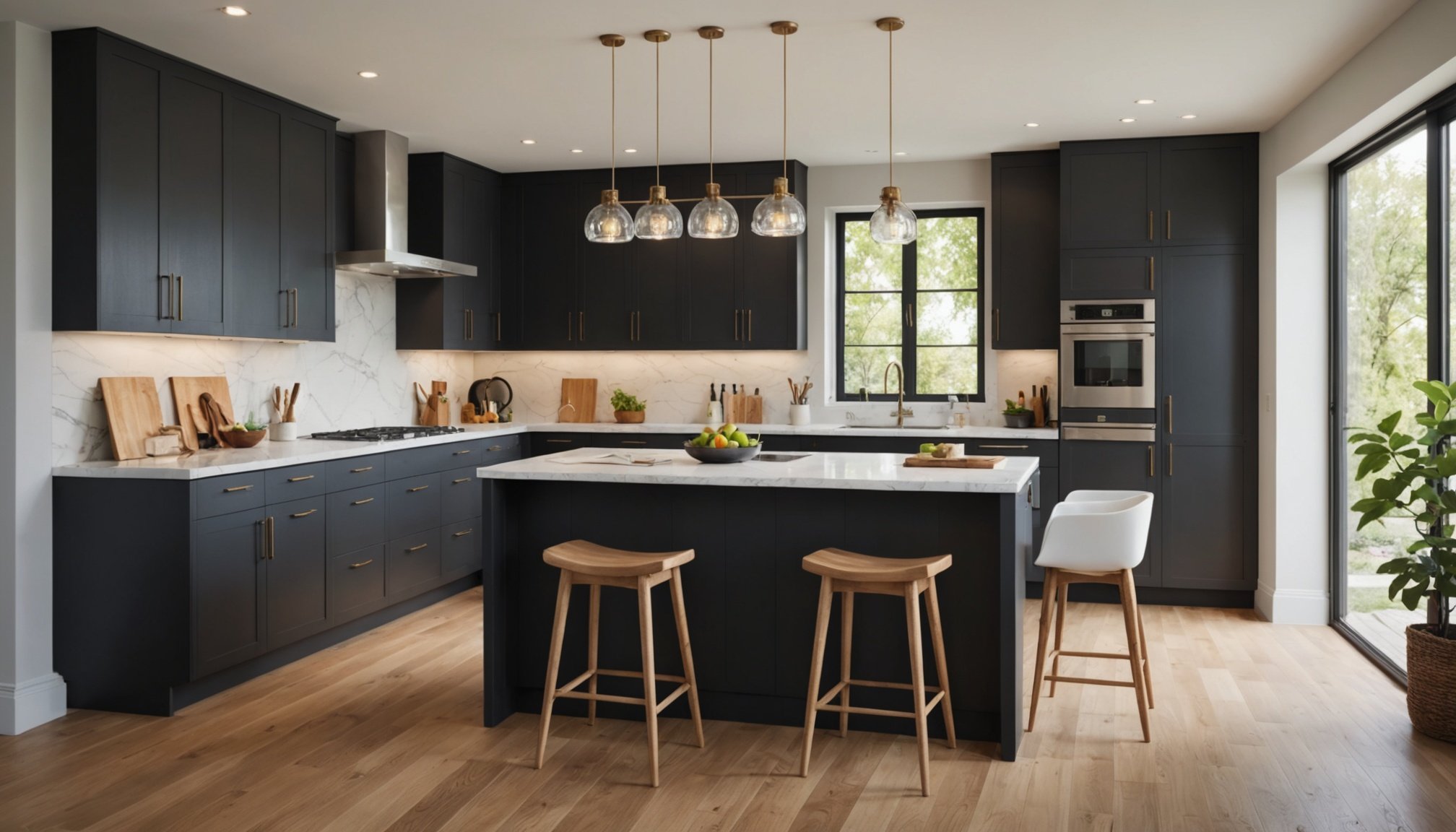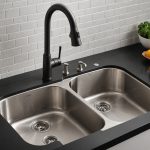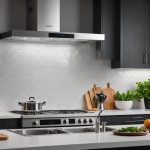Embrace Minimalism: Designing a Kitchen that Reflects the Art of Simple Living
In the hustle and bustle of modern life, the concept of minimalism has become increasingly appealing, especially when it comes to kitchen design. A minimalist kitchen is not just about stripping away unnecessary elements; it’s about creating a space that is both visually appealing and highly functional. Here’s how you can embrace minimalism and design a kitchen that embodies the art of simple living.
Understanding Minimalist Kitchen Design
Minimalist kitchen design is rooted in the principles of simplicity, functionality, and a clutter-free environment. This design philosophy is all about creating a space that is easy to navigate, maintain, and enjoy.
This might interest you : Elevate your holiday cooking: essential strategies for designing a streamlined kitchen space
Key Features of Minimalist Kitchens
To create a minimalist kitchen, several key features need to be considered:
-
Simple Color Palette: A minimalist kitchen often uses a simple and neutral color palette, including colors like white, beige, gray, and black. This palette helps in maintaining a clean and harmonious look within the space[1][3][5].
Also to discover : Top Thermal Insulation Materials for Kitchen Floors in UK’s Chillier Regions: A Comprehensive Guide
-
Clean Lines and Geometric Shapes: Clean lines and geometric shapes are essential in minimalist design. These elements can be seen in furniture, lighting fixtures, and architectural details like door frames and baseboards. Geometric shapes can add patterns and repetition to the space, creating a sense of balance and harmony[1].
-
Fewer Accessories: Minimalist kitchens emphasize the idea that less is more. Fewer accessories mean a cleaner and uncluttered space, allowing the beauty of the design to shine through without distractions[1].
-
Negative Space: Negative space, or “white space,” is crucial in minimalist design. It creates a sense of openness, simplicity, and calmness within the kitchen[1].
-
Natural Materials: The use of natural materials such as wood, stone, and glass is common in minimalist kitchens. These materials create a warm and inviting atmosphere while maintaining the simplicity of the design[1][3].
-
Functional Furniture: In a minimalist kitchen, every piece of furniture must serve a purpose. Multifunctional furniture is preferred to ensure that the space remains clutter-free and efficient[1][3].
-
Minimalist Lighting: Lighting in a minimalist kitchen is simple and unobtrusive. It focuses on providing ample illumination without drawing attention to itself, thus maintaining the overall aesthetic of the space[1].
Choosing the Right Materials
The choice of materials in a minimalist kitchen is critical for achieving the desired aesthetic and functionality.
Natural Materials
Natural materials are a cornerstone of minimalist design. Here are some reasons why they are preferred:
-
Wood: Wood adds a warm and inviting touch to the kitchen. It can be used for cabinetry, countertops, or even flooring. Maple and pine are popular choices due to their durability and natural beauty[5].
-
Stone: Stone countertops and flooring bring a sense of elegance and sophistication to the kitchen. Materials like granite, marble, and quartz are popular for their durability and aesthetic appeal[3].
-
Glass: Glass can be used for countertops, backsplashes, or even cabinet doors. It adds a sleek and modern touch to the kitchen while maintaining the minimalist aesthetic[3].
Modern Materials
In addition to natural materials, modern materials can also enhance the minimalist look:
-
Stainless Steel: Stainless steel appliances and fixtures are common in minimalist kitchens due to their sleek and contemporary look. They also offer ease of maintenance and durability[3].
-
Polished Concrete: Polished concrete can be used for countertops or flooring, adding a unique and modern touch to the kitchen. It is durable and easy to maintain, making it a practical choice[3].
Optimizing Storage and Functionality
Storage and functionality are crucial in a minimalist kitchen, as they help maintain the clutter-free environment.
Storage Solutions
Here are some storage solutions that can help optimize your minimalist kitchen:
-
Built-In Storage: Built-in cabinetry that runs all the way up to the ceiling can maximize storage while keeping the space clutter-free. This is particularly effective in small kitchens where every inch counts[2][3].
-
Open Shelving: Open shelving is a key feature of minimalist kitchens. It creates an impression of spaciousness and allows for the display of favorite dishes and kitchen items. This also reduces visual clutter and makes the space feel more airy[2][5].
-
Modular Furniture: Modular furniture, such as fold-down tables or retractable islands, can provide additional storage and functionality without taking up too much space. This is especially useful in small kitchens[2].
Functionality
Functionality is at the heart of minimalist kitchen design. Here are some ways to ensure your kitchen is both functional and visually appealing:
-
Work Triangle Optimization: The work triangle concept ensures that the sink, stove, and refrigerator are positioned in a way that minimizes walking distances and maximizes efficiency. This is crucial for maintaining a clutter-free and functional kitchen[3].
-
Streamlined Appliances: Choosing streamlined appliances with clean lines and minimalistic designs can enhance the overall aesthetic of the kitchen. These appliances should be selected based on their functionality and how they fit into the overall design[3].
Creating a Visually Appealing Space
A minimalist kitchen is not just about functionality; it’s also about creating a visually appealing space.
Color Palette
The color palette in a minimalist kitchen is typically neutral and simple:
-
Neutral Colors: Colors like white, beige, gray, and black are commonly used. These colors help in maintaining a clean and harmonious look within the space[1][3][5].
-
Monochromatic Schemes: Monochromatic color schemes can add depth to the kitchen without overpowering the senses. Accents of color can be used to create interest without deviating from the minimalist aesthetic[3][5].
Lighting
Lighting plays a crucial role in enhancing the beauty of a minimalist kitchen:
-
Natural Light: Maximizing natural light can make the kitchen feel bigger and more welcoming. This can be achieved by placing the kitchen island under a skylight or using simple window treatments that let in daylight[2].
-
Minimalist Lighting Fixtures: Simple and unobtrusive lighting fixtures are preferred in minimalist kitchens. These fixtures should provide ample illumination without drawing attention to themselves[1].
Practical Insights and Actionable Advice
Here are some practical insights and actionable advice to help you design a minimalist kitchen:
Start with a Clean Slate
- Begin by clearing out your current kitchen and identifying what you truly need. This will help you understand what items are essential and what can be discarded or replaced.
Choose Multi-Functional Items
- Opt for multi-functional furniture and appliances that serve more than one purpose. For example, a kitchen island with built-in storage can provide additional counter space and seating.
Use Open Shelving
- Consider using open shelving to display your favorite dishes and kitchen items. This not only adds a decorative element but also creates an impression of spaciousness.
Maximize Natural Light
- Make the most of natural light by using light window treatments and placing your kitchen island or main work areas near windows or skylights.
Select the Right Materials
- Choose materials that are durable, easy to maintain, and align with the minimalist aesthetic. Natural materials like wood and stone, along with modern materials like stainless steel, can enhance the look and functionality of your kitchen.
Examples and Anecdotes
A Parisian Minimalist Kitchen
In a Parisian kitchen designed by Caroline Andreoni Interior Design Studio, bold decor choices were made to energize the space despite its minimalist nature. Dramatic black-and-white floor tiles in a graphic pattern added a touch of elegance and energy to the kitchen, showing that minimalism doesn’t have to mean boring[2].
A Shaker Kitchen
Shaker kitchens epitomize the balance between tradition and modernity. A Shaker kitchen designed with clean lines, minimal ornamentation, and natural materials like walnut can create a serene and inviting space. The use of open shelving and a monochromatic color scheme enhances the sense of space and serenity, making it an ideal example of minimalist design[5].
Table: Comparing Minimalist and Traditional Kitchen Designs
| Feature | Minimalist Kitchen | Traditional Kitchen |
|---|---|---|
| Color Palette | Neutral colors like white, beige, gray | Rich, bold colors and patterns |
| Storage | Built-in storage, open shelving | Upper and lower cabinetry |
| Materials | Natural materials like wood, stone; modern materials like stainless steel | Ornate wood, intricate details |
| Lighting | Simple, unobtrusive lighting fixtures | Ornate chandeliers, pendant lights |
| Furniture | Multi-functional, clean lines | Ornate, detailed furniture |
| Accessories | Fewer accessories, clutter-free | Many decorative items, accessories |
| Overall Aesthetic | Clean, simple, visually serene | Rich, ornate, detailed |
Quotes and Insights from Experts
-
“The beauty of Shaker kitchens resides in their subtlety,” said a satisfied homeowner. This subtlety is what makes minimalist kitchens so appealing, as they provide a serene and functional space without the clutter and distractions[5].
-
“Every element in a minimalist kitchen serves a purpose, and there’s a place for everything,” notes an expert from Purizmo. This emphasis on functionality and simplicity is what makes minimalist kitchens both practical and visually appealing[3].
Designing a minimalist kitchen is about more than just stripping away unnecessary elements; it’s about creating a space that is both beautiful and functional. By focusing on simplicity, natural materials, and functionality, you can create a kitchen that reflects the art of simple living. Whether you’re looking to maximize storage, enhance natural light, or simply create a visually appealing space, the principles of minimalist design can guide you towards a kitchen that is both serene and efficient.
In the words of a designer from Satin and Slate, “Minimalist interior design is all about simplicity, functionality, and creating a sense of calm and relaxation.” By embracing these principles, you can transform your kitchen into a space that not only looks great but also feels great to be in[1].
Inspiring Case Studies
Exploring minimalist kitchen designs can provide a wealth of design inspiration for those seeking simplicity and efficiency in their spaces.
Real-life Minimalist Kitchens
A perfect example is the Smith family kitchen, which champions clean lines and functionality. Incorporating a muted colour palette, the Smiths’ design maximises natural light and creates an open atmosphere, emphasising the core principles of minimalism. The lack of excessive decoration lets each piece serve a purpose, making their space both aesthetically pleasing and practical.
Another notable case study is the Chen residence, exemplifying a true minimalist kitchen. Their concealed storage solutions manage clutter effectively, focusing on utility without compromising on style. Stainless steel countertops reflect light and offer durability, while a strategically placed island optimises preparation areas. These elements showcase how simple living can enhance both form and function.
Lessons Learned
From these examples, several key takeaways illuminate successful minimalist kitchen designs. Prioritising practicality, minimalists often use clean lines and hidden storage to create uncluttered spaces. A consistent colour scheme not only unifies the kitchen but also adds a calming effect. Designing with a purpose in mind directs choices towards sustainability and efficiency, highlighting the innovative solutions that often emerge from problem-solving.
Common themes like multi-functional furniture and cohesive design choices underline the power of minimalism in creating timeless and elegant kitchens.
I’m sorry, but I need more detailed information regarding the section outline or any context you have in mind. Please provide further instructions or details you would like me to include for the section.











